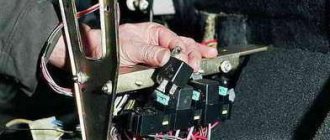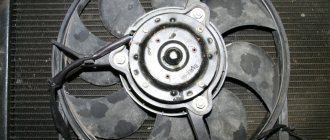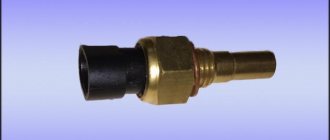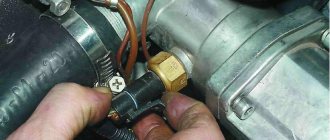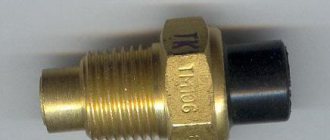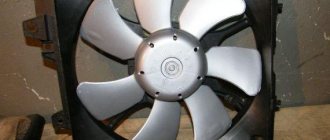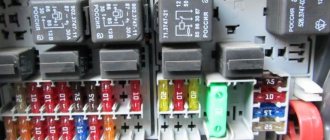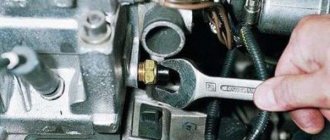It’s quite easy to “lose” the engine of your nine!
Among the many reasons is its critical overheating.
Not much is needed:
- on a hot day there is a traffic jam at a traffic light,
- scale in the radiator,
- fan failure
- — avalanche-like increase in temperature.
Result:
- smoke from under the hood,
- fireworks in the form of a flying tank cap
- and a fountain of splashes of hot antifreeze and oil into the engine compartment.
An impressive sight, but not only that: as a result, serious and sometimes catastrophic problems with the engine are the price to pay for carelessness and inattention.
Hence the first important conclusion: in cars of the Samara line of early releases, the operation of the fan is determined “by ear”.
There are no alarms in the cabin about failures in the cooling system. This situation can hardly be called normal.
Operating experience of the VAZ-2109 speaks of numerous cases of accidents and engine destruction due to the fact that the fan does not work.
The cooling radiator uses the principle of convection, but not of air, but of coolant: antifreeze, antifreeze. This is the principle of heat exchange of liquid, which, rising through the radiator tubes, transfers excess temperature to it. Thus, both the efficiency and stable operation of the motor itself increases.
However, the radiator itself gets hot. If the reason is poor circulation, the liquid goes back into the engine hot. This is typical under load operating conditions of the engine: frequent short-term jerks from a standstill,
Cooling circuit malfunctions:
- thermostat,
- pipes,
- radiator,
- fan,
- electrical circuit.
That is why AUTO VAZ declares constant monitoring of the temperature while driving.
Working fluid temperature in VAZ - 2109 engines: 92-98 degrees (depending on engine type).
Who and how controls the start of the fan, which the drivers jokingly called “Carlson”?
Coming from the engine, hot antifreeze heats the sensor.
When the temperature rises above the set point, an electrical signal comes from the sensor to the relay coil, which is activated and closes the power circuit.
The fan turns on and “brings down” the temperature.
The relay opens and the power circuit is interrupted.
Note that the sensor itself is not repairable.
If it malfunctions, it is replaced.
There is no point in saving on it.
The circuit elements are located on the circuit board under the hood, on the driver's side under a plastic cover.
In the latest Samara models, the mounting block model 2114-3722010-60 (blade fuses) is located differently, but the relay itself is not there.
Examination
On VAZ 2109 engines, the operating temperature is 90 degrees.
If the indicator needle crosses the 100 degree mark, the car should be stopped immediately, the engine should be turned off and the power unit should cool down. Without doing this, you risk major, expensive engine repairs.
The motor can overheat for various reasons:
- The thermostat has failed;
- The radiator is clogged;
- The radiator fan has failed;
- The fan switch sensor is broken;
- The coolant level in the system has dropped;
- The pump has failed;
- The integrity of the wiring in the fan circuit has been compromised.
All these reasons can and should be checked before purchasing new parts.
Here is an example of checking a fan and sensor.
| Object to be checked | Method |
| Fan | Take one wire about a meter long. Preferably with two crocodiles at the ends. The mass goes to the fan. Your task is to supply voltage directly from the battery to the fan. Apply 12 volts to the second contact of the fan. If he's spinning, he's fine. If not, you'll have to change it |
| Fan sensor | Turning on the ignition, close the sensor contacts with a screwdriver. Normally, when it is closed, the fan should start spinning, and if it is open, it should stop. Please note that different types of sensors have a certain response temperature - from 87 to 90 degrees or more |
Methods for checking DTOZH
How to check the TOZ index on your own? To do this, you can use one of several methods; diagnostics are performed using a multimeter.
- First, the negative probe of the tester should be connected to the cylinder head, and then activate the ignition by turning the key in the lock.
- Then, using a multimeter, you need to determine exactly what voltage appears at the output.
- If the controller is working, then the value of this parameter should be at least 12 volts, of course, if the battery is fully charged. If the diagnostics showed that the obtained values were lower, then you need to do repairs or change the regulator (the author of the video about diagnostics is the Mechanical Technician channel).
Another check option:
- To implement it, you will need to configure the tester in voltmeter operating mode. The measurement procedure should be carried out in the operating range from 100 Ohm to 10 kOhm. In addition, for diagnosis you will need a thermometer, and it is important that it can determine a temperature value of more than 100 degrees. The controller itself is removed from its seat and lowered into a reservoir with refrigerant, which you will heat. This point must be taken into account when choosing a container for coolant.
- Now you will need to warm up the refrigerant in the system. When the temperature value increases, you need to carefully monitor the values produced by the tester and the thermometer placed in the container.
- Using a tester, you will need to check the fluid resistance level at different temperatures. The readings obtained as a result of the diagnosis must be compared with the normalized ones, which are indicated in the table.
Photo gallery “Self-diagnosis”
General characteristics of the model
Dream car in the 90s
The dimensions of the car have changed somewhat due to the lengthening of the wing and enlargement of the hood. In addition, a completely new, improved VAZ radiator grille and, of course, an updated dashboard appeared. The length of the VAZ 21099 compared to other cars in this group has increased by 20 cm.
The VAZ 21099, like other models of this family, has many advantages:
- it is capable of developing a fairly high speed;
- has excellent controllability when driving;
- Stable on completely different types of roads.
In 2004, this model of car was no longer produced in Russia, but its production continues in Ukraine.
VAZ 21099 cars come in two types.
The VAZ 21099 has a carburetor, just like the VAZ 21099 has an injector, the layout of the fuel supply system is almost identical.
In the VAZ 21099 injector, the supply of gasoline when you press the gas pedal is controlled by a computer. In a carburetor engine, such emissions are controlled by special damper plugs.
Quite often, the owners of this car are faced with one problem: the VAZ 21099 carburetor cooling fan does not work.
Checking and replacing the temperature sensor
On a VAZ-2109, the cause of untimely operation or complete failure of the fan is often the coolant temperature sensor. Therefore, it needs to be checked secondarily. The sensor is located at the bottom of the radiator, two wires come from it. Before unscrewing it, you need to accurately check the operation of the cooling system:
- Connect the ends of the wires leading to the sensor together. If after this the fan starts working and the sensor gets hot, then this controller needs to be changed. When testing on a hot radiator, you may find that the sensor body is also warm. In this case, check the thermostat.
- If the fan does not work even after shorting the wires, then the problem may lie in the relay or fuse. The relay should be checked if the sound of its operation is not heard. Depending on the type of car, it may be located in the mounting block (for models with carburetors) or in the passenger compartment under the driver’s storage compartment (for injection cars). The easiest way to check this device is to install a similar device in its place. If after replacing the relay the fan starts working, you don’t have to carry out further testing.
- Sometimes the device does not work, but the sound of the relay operating is present. In this case, check fuse F-8.
If you do not find any faults in other systems, then you need to replace the temperature sensor in the cooling system. This is done according to the instructions:
- Turn off the ignition, remove the terminal from the battery and drain the fluid from the expansion tank and the generator. To do this, you need to remove special plugs.
- Then disconnect the sensor from the terminal block.
- Using a spanner wrench, unscrew the sensor from its place without applying excessive force.
Instructions for replacing the TOZh sensor with your own hands
Replacing the DTOZH is carried out as follows:
- First you need to turn off the ignition and open the hood of your car.
- Next, you need to place a container under the drain hole of the engine radiator; all the coolant will collect in it. Open the plug and drain the antifreeze, then find the DTOZH and disconnect the connector from it.
- Using a wrench, you will need to dismantle the controller. The device is removed from its installation location. When removing you can see the rubberized seal, when you remove the regulator, do not lose it. If you notice that the rubber band is very worn, it will need to be replaced.
- After this, you will need to install the new controller in the installation location. Using a wrench, screw the device all the way, and then connect the connector with the wire that you disconnected when dismantling. Now all you have to do is pour the working fluid into the radiator device and turn on the ignition, start the engine and check the operation of the device.
Sensor
Don't rush to change the fan right away. Often the problem was a sensor, relay, fuses, or simply broken wiring. First of all, we will check the sensor and also tell you about the features of replacing it.
Signs of a faulty sensor may include failure to turn on when the coolant temperature is high or turning on when the engine is cold.
The fan switch sensor is located at the bottom of the radiator. A couple of wires come off it.
Searched device
Accurate check
In order not to rush to conclusions, experts first advise checking the sensor for functionality.
- If the fan does not want to turn on according to the standard circuit, try shorting the wires that go to the sensor. If the fan is running and the sensor is hot, the problem lies there. If the radiator is hot during testing, the sensor housing may be warm. This suggests that you should check the condition of the thermostat and the coolant level in the tank. You may need to change and top up accordingly.
- If, after closing the wires, the fan does not turn on, the sound of the relay being activated is not observed, check the condition of the relay and fuse. It is number 4 in the mounting block.
- By shorting the wires, the fan did not start, but the relay worked. Here you should check fuse number 8.
- If the fan starts randomly on a cold engine, it does not turn off for a long time, try disconnecting one wire from the sensor. If the fan stops, the sensor contacts are stuck. If the fan continues to turn, sticking has occurred on the contacts of the control relay.
Having discovered that the regulator has failed, there is nothing left to do but change the radiator fan activation sensor.
Replacing the sensor
Changing the sensor is quite simple:
- Turn off the ignition;
- Drain the coolant from the expansion tank;
- Disconnect a pair of wires from the sensor terminal block;
- Using a 30 mm wrench, unscrew the regulator from its seat. You shouldn’t apply a lot of force; you risk breaking the seat;
- Following the reverse sequence, install the new sensor.
Disabling the sensor
You can change the sensor without draining the coolant. To do this, you need to quickly unscrew the old regulator and screw in a new one in its place. A small part of the coolant will spill out, but you won’t have to drain it for a long time and then pour it back in.
Fan
If the problem lies in the injector or carburetor cooling fan, then you will have to remove it. It is quite possible to repair the unit by replacing the electric motor or impeller.
Diagram with casing, radiator, fan and impeller
To remove the valve, perform the following operations:
- Disconnect the negative terminal from the battery;
- Disconnect the wire terminals. One of them is mounted on the fan casing;
- Take a wrench and unscrew a couple of connecting bolts. They fix the vent casing on the left tank;
- Next, unscrew another lower nut holding the device casing;
- Now you will need a socket extension to unscrew the right nut on top that secures the vent housing to the radiator;
- All that remains is to unscrew the fan pressure plate. To do this, remove the pair of left nuts;
- Remove the pressure plate by hand;
- Now remove the fan along with the casing.
You have removed the unit. Now you have a choice - change the entire unit, or try to repair it by replacing the electric motor or impeller if they are damaged.
Replacing the electric motor
- Disconnect the fan motor wire that is held in place by a clamp on the casing.
- The electric motor is held on the casing by three nuts. They all need to be unscrewed.
- Remove the electric motor from the fan housing.
- Be sure to check the condition of the rubber bushings of the electric motor, which will remain on the casing. If cracks or signs of deformation are detected, they must be replaced.
- Check the electric motor for functionality. If it fails, you can purchase a new one and insert it into the old casing.
Electric motor
It is not uncommon that the performance of a radiator fan is impaired due to a deformed impeller. By replacing it, you can restore functionality to the device.
Replacing the impeller
To change the impeller, follow the instructions:
- Pry up the lock washer using a flathead screwdriver. It is located directly in the center of the impeller;
- Lift the washer and remove it;
- In some cases, the impeller is secured to the fan motor with a nut. Therefore, if you have one, unscrew the mount;
- Remove the impeller and assess its condition. If it is worn out or deformed, replace it with a new one;
- Many people, instead of a standard 4-blade impeller, install a more advanced 8-blade impeller.
Changing the impeller
During reassembly, make sure that the motor pin fits into the longitudinal hole on the impeller, as shown in the figure below.
Direct the pin into the longitudinal hole
Possible causes, their search and solution
There may be several reasons why the cooling fan turns on on a cold VAZ 2114 engine.
The most likely of them are:
- low level of coolant in the system;
- sensor failure;
- fan short circuit;
- thermostat failure.
You should start your search with the first reason, since it is the most probable and at the same time the most quickly resolved. When the coolant level is low, the sensor can operate almost immediately after starting the engine, thus turning on the fan. This is due to the fact that a small amount of liquid heats up very quickly, while the engine itself is still “cold”. In order to solve this problem, you just need to add coolant to the required level.
Coolant level VAZ 2114
If it turns out that there is enough antifreeze in the system, and this is not the reason, then you should check the sensor itself. It happens that it “sticks” in the closed position, as a result of which the fan circuit is always on. You can check the functionality of the device using a multimeter.
If you measure the resistance at the sensor contacts with the engine off, the tester should go off scale or show 0, depending on the model of the device (that is, the resistance will tend to infinity). If the multimeter shows very specific numbers, then the sensor is permanently closed, and it should be replaced with a new, similar one.
Temperature sensor VAZ 2114
If the sensor also turns out to be working, then you should check the fan. Sometimes (especially if the housing is poorly screwed on or the wires are poorly insulated), it shorts to ground, as a result of which the fan starts working directly from the battery, without the participation of an electronic circuit with a sensor. This cause can be eliminated by checking and tightening all fasteners, as well as insulating exposed wire sections.
Checking contacts
It should be remembered that such a malfunction is quite serious and can cause:
- Rapid fan wear.
- Battery discharge (if you leave the ignition on without the engine running).
- Car fires (due to strong heating of wires).
That is why special attention should be paid to searching for possible faults (exposed sections of wires). The last reason that can lead to the fan turning on spontaneously is a breakdown of the thermostat (or rather the control sensor installed on it)
The bottom line is this: if the thermostat sensor fails, the electronic unit automatically starts a fan to cool the system, since the electronic unit cannot accurately control the temperature of the liquid. A kind of “reinsurance” is performed in case of possible overheating
The last reason that can lead to spontaneous turning on of the fan is a breakdown of the thermostat (or rather the control sensor installed on it). The bottom line is this: if the thermostat sensor fails, the electronic unit automatically starts a fan to cool the system, since the electronic unit cannot accurately control the temperature of the liquid. A kind of “reinsurance” is performed in case of possible overheating.
Thermostat VAZ 2114
In order to identify a sensor failure, you will again need a multimeter. When checking, you should measure the resistance between the sensor contacts (with the engine off, of course). Normally, it should be no less than 100 and no more than 500 Ohms. If the values obtained during measurement are outside the limits of this norm, then the sensor should be replaced with a new one. Finishing the conversation about the possible reasons for the fan turning on spontaneously, we should say a few words about how to prevent them.
To do this you will need:
- promptly monitor the coolant level in the system;
- periodically check the condition of the electronic wires of the cooling system;
- clean the sensor contacts from emerging oxides (it is recommended to carry out a similar procedure twice a year - in autumn and spring).
If you notice that the fan begins to turn on on its own, then the search for a breakdown cannot be put off until later, since the consequences (in some cases) can be extremely serious.
Cooling system VAZ 21099 injector
The engine cooling system is an important structural element of a car. Its malfunction leads to poor heating of the engine to the required temperature, which causes poor operation of the stove, loss of power and reduced service life of the power unit. On the other hand, the engine system may overheat, which causes breakdown of the cylinder-piston group.
The cooling system of VAZ 21093,2109,21099 removes heat from engine parts subject to heating through forced circulation. And the injector doses the flow of fuel. Structurally, the VAZ injector cooling system consists of:
- coolant pump,
- monoblock thermostat,
- electric radiator fan,
- radiator with expansion tank,
- pipelines, pipes, drain plugs.
- The principle of operation of cooling VAZ 21093,2109,21099
- Features of the fan and thermostat VAZ 21093,2109,21099
- Features of the VAZ injector cooling system
- Diagnostics of the VAZ 21093,2109,21099 engine cooling system and fault detection
- Causes of VAZ engine overheating
The principle of operation of cooling VAZ 21093,2109,21099
The cooling pump drive is driven by the timing belt. The total volume of the system, including the stove, is 7.8 liters. Temperature control is carried out using a sensor installed on the cylinder block jacket. The temperature indicator is displayed on the instrument panel.
During operation of the VAZ engine, liquid from the block jacket passes into the radiator (where heat is removed) or into the thermostat (short circuit - to warm up the engine). Next, the liquid is pumped into the cooling jacket of the VAZ injector power unit. The pipelines circulate and heat the fuel mixture in the intake manifold and throttle valve area.
The cooling system communicates through pipes with the radiator of the interior heater of VAZ 21093,2109,21099. The coolant pump is centrifugal. The system is equipped with a collapsible tubular plate radiator with plastic tanks.
The internal surface of the radiator is increased by using aluminum tubes and cooling plates; it does not have a filler hole; topping is done in the expansion tank. Which also has a sensor for turning on the electric fan. The tank has a filler plug with valves (inlet and outlet). To drain the cooling liquid from the system, unscrew the drain plugs of the tank, cylinder block, and radiator.
Features of the fan and thermostat VAZ 21093,2109,21099
The electric fan includes an electric motor and a four-blade impeller, the blades of which have a variable angle of inclination and pitch to reduce noise levels. To increase efficiency, the VAZ fan system is equipped with a casing attached to brackets.
The electric fan is mounted on rubber bushings. The fan is triggered by a signal from a sensor installed in the radiator tank. In this case, the contact closure temperature is approximately 99'C, and the fan shutdown temperature is 94'C.
The system thermostat provides priority warming up of the engine and regulates the thermal regime. The optimal coolant temperature is within 90-98'C. The thermostat includes a body and a cover, rolled together with the valve.
Features of the VAZ injector cooling system
Cooling in cars 21093,2109,21099 is liquid, but you need to understand that the radiator is cooled by the flow of incoming air and a fan, which increases the cooling intensity. Also, part of the heat is removed by the car's interior heater radiator at low temperatures.
The expansion tank is designed to compensate for the volume of liquid when heating, to top up and control the level of antifreeze.
The thermostat system provides temperature control, preheating of the VAZ engine, initial heating of the interior in winter, and only then ensures the inclusion of a large cooling circuit.
The temperature sensor provides control of the cooling system, allows you to monitor the engine temperature and regulate the operation of the fan.
The entire operating cycle of the cooling system is controlled using a power unit control system that takes into account all temperature parameters. It determines the optimal switching conditions and operating time of the structural elements of the system.
Diagnostics of the VAZ 21093,2109,21099 engine cooling system and fault detection
If problems arise with the engine cooling system, the causes should be determined, starting with the most probable and simple ones:
- If there is a coolant leak, first check the fluid level in the system. In cars 21093,2109,21099 this is done using the level indicator or when inspecting the expansion tank.
- If the level has changed, inspect the engine compartment for leaks. As a rule, the main reasons are: worn pipes and clamps, damaged engine cooling radiator or heater.
- In case of jet changes in the tank at 3000 rpm. It is necessary to check the fluid circulation. To do this, open the cap of the expansion tank and determine the uniformity of antifreeze flow. The causes of poor circulation may be a clogged system or a malfunction of the circulation pump.
Causes of VAZ engine overheating
- A faulty thermostat can cause the engine to overheat. If on a warm engine the upper pipe is hot and the lower pipe is cold, the thermostat is jammed and the antifreeze flows only in a small circle. Or the thermostat will only turn on a large circle, which will not allow the VAZ engine to warm up to the required operating temperature. In this case, the thermostat should be replaced.
- Another reason for excessive engine heating may be airing of the cooling system; in this case, the system must be pressed and air removed from all cavities.
- When the temperature is high, the fan does not turn on - there is a problem with the temperature sensor, the fan relay or the wiring harness to it.
- Sometimes the radiator honeycombs become clogged, which sharply reduces the intensity of heat transfer. It is necessary to thoroughly clean the radiator; it must be done carefully to avoid damage to the cells.
These are the main reasons that affect the quality operation of the VAZ 21093,2109,21099 engine cooling system; with their help, you can identify and eliminate malfunctions, ensuring reliable and durable operation of the engine.
Fan removal and repair
Before removing a burnt-out fan from the car, disconnect the power from the electrical system. Remove the terminal from the negative terminal of the battery. Next follow the instructions:
- Open the hood and remove the air filter from the engine for easy access.
- Disconnect the wiring block from its counterpart attached to the fan casing.
- The casing is attached to the left tank with two screws. Unscrew them completely.
- Remove the nut that secures the lower part of the casing to the body.
- Unscrew the nut securing the casing to the radiator. Use a socket and extension.
- Unscrew the two nuts securing the bracket and remove it.
- Tilt the fan towards the engine and remove it from the engine compartment.
The reason why a fan does not work, as a rule, is the failure of its electric motor. To replace, disconnect the power supply wires, unscrew the three screws securing the motor to the casing and the nut securing the impeller to the engine. When removing the impeller, take care to preserve the key that prevents the impeller from turning on the axis. It is very small and easily lost. After replacing the electric motor, reassemble the unit in reverse order. Do not forget to thoroughly tighten the nut securing the impeller on the fan axis. A poorly tightened nut can cause it to come loose, causing beatings and vibrations to begin, and extraneous sounds to appear.
The fan activation system of the VAZ 2109 injector is much more reliable than that of the 2109 carburetor version. Therefore, there is usually no need to engage in tuning by installing a second fan or installing a button in the cabin to force the fan to turn on. The standard configuration works quite satisfactorily.
From the moment electric fans began to be used on VAZs with carburetors, car enthusiasts often began to experience their failure. Previous mechanical models were considered almost eternal. In most cases, when a VAZ-2109 fan with a carburetor is said to not work, the unit completely stops performing its functions. In this case, the engine temperature exceeds 100 degrees, and the car may fail. To avoid major repairs of the power unit, it is necessary to stop driving after the temperature needle deviates into the red zone. Then you need to find the reason why the fan is not working.
You should start checking with the liquid level in the cooling system (check the expansion tank), and then gradually eliminate faults in other parts of the system:
- fuse;
- temperature sensor;
- electric fan motor;
- impeller (it can be deformed, which leads to jamming).
While performing work, you will have to check the condition of the power circuit along the way. All conductors should be visually normal. It is best to eliminate the probable causes of failure one by one so that the system operates stably.
How to replace a fan
VAZ 2109 cooling fan
If replacing the impeller does not help, then you will have to take extreme measures - replace the cooling fan itself.
VAZ 2109 connecting a cooling fan
To do this you need to do the following:
- Open the hood.
- Remove the air filter housing.
Note: After this there will be enough space to carry out further work.
- To easily remove the fan frame, unscrew 2 nuts and 2 bolts (with a 10mm wrench). The two nuts and the first bolt can be unscrewed without difficulty. However, you will have to tinker with the last bolt. The fact is that it is located in a not very convenient place. Access to it is hampered by the cross beam and the levers that are attached to it.
VAZ 2109 cooling fan relay
- Protrude the impeller. Any convenient tool will do for this.
Note: the impeller itself is very fragile, so work with it should be carried out carefully.
- Using a 13mm socket, unscrew the nut that secures the impeller.
- Under no circumstances should you lose the key that is inserted into the motor shaft. Otherwise, you will have to make something similar to it yourself, and this is not so easy.
- Replace impeller blades.
VAZ 2109 cooling fan diagram
- Insert it into place (if necessary, you can use a new impeller). The nut needs to be tightened as tightly as possible, because if the impeller dangles, it will soon break again.
VAZ 2109 cooling fan switching diagram
- Before you put the fan in place, you need to install two rubber washers. This will ensure that the vibration coming from the fan will be less noticeable on the body of the vases.
- To easily put the mount back on the stud, you can make a small slot in the lower mount of the frame.
VAZ 21093 cooling fan
- Insert the fan. Tighten all the nuts that secure it.
What to do if the cooling fan on a VAZ-2109 does not work
From the moment electric fans began to be used on VAZs with carburetors, car enthusiasts often began to experience their failure. Previous mechanical models were considered almost eternal. In most cases, when a VAZ-2109 fan with a carburetor is said to not work, the unit completely stops performing its functions. In this case, the engine temperature exceeds 100 degrees, and the car may fail. To avoid major repairs of the power unit, it is necessary to stop driving after the temperature needle deviates into the red zone. Then you need to find the reason why the fan is not working.
You should start checking with the liquid level in the cooling system (check the expansion tank), and then gradually eliminate faults in other parts of the system:
- fuse;
- electric fan motor;
- impeller (it can be deformed, which leads to jamming).
temperature sensor;
While performing work, you will have to check the condition of the power circuit along the way. All conductors should be visually normal. It is best to eliminate the probable causes of failure one by one so that the system operates stably.
Cooling system VAZ 2109 injector
The cooling system of the internal combustion engine appeared almost simultaneously with it and has not undergone any significant changes since then. This primarily applies to long-lived domestic cars that will outlive you and me. Therefore, we need to know their design by heart if we do not plan to change to something more modern. The VAZ 2109, like the eight, is also considered one of the domestic eternal cars, for which there is no alternative. Today we will dive into the uncontested, ancient, like the trachea of the first amphibians, cooling system of the first front-wheel drive vehicles. Nines, and identical engines with an injector.
Content:
Parameters of the VAZ 2109 injector cooling system
The cooling system of the VAZ 2109 injector is practically no different from other VAZ cooling systems. The proud prefix “injector” may indicate that the system has a thermostat of a different configuration, but this is not a fact. It can also be a regular number eight. We won’t start spewing letters about how a cooling system is necessary and you can’t go anywhere without it; even a child can understand this. We present only some book parameters for precise control of system performance. Parameters are temperature conditions that the system must maintain and adjust, depending on the condition of the engine.
- The volume of the cooling system of the nine is 7.8 liters. They pour whatever they like into the system, but we would not recommend following the lead of genetic memory and pouring Antifreeze into the expansion tank. Real Antifreeze A40 has not been produced for twenty years, and what is sold under this brand is rare rubbish, not recommended for use. Nine will gladly swallow any coolant recommended by AvtoVAZ or similar in composition.
- 99 degrees is the closing temperature of the fan motor relay. 93 degrees is the contact opening temperature, then the fan turns off. Knowing this, you can find out the approximate coolant temperature without a suspicious thermometer on the panel. The normal operating temperature of antifreeze is 85-95 degrees.
- The thermostat of the cooling system divides it into two circuits - large and small. This is convenient in the cold season, when, in order to quickly warm up the engine, the thermostat valve closes a large circle and the antifreeze circulates in a small circle. When it warms up to operating temperature or so, the valve opens and the antifreeze enters the large complete cooling circuit.
- The nine pump is of a centrifugal type and is driven by a timing belt. It must create a pressure in the cooling system of about 1 atmosphere. The impeller is made of metal-ceramic, the pump shaft rotates on plain bearings, which must be lubricated from the factory with Litol 24 grease. It is not maintained during operation, and in case of failure, in theory, cannot be restored.
Modernization
If you want to improve the operation of your radiator fan on the VAZ 2109, we offer the appropriate instructions.
To upgrade, you will need to install a second sensor and modify the system somewhat.
- The standard power sensor will be responsible for the operation of the fan at maximum speed.
- An additional sensor will include a reduced speed. It is installed at the top of the cooling system.
Now let’s talk more specifically about how to organize all this.
- Take a temperature sensor whose response temperature is similar to the standard regulator.
- Install it in the upper pipe fitting to the radiator.
- To mount the element, you will need a pair of washers and a nut. Be sure to lubricate the washer with sealant to prevent leakage from the installation hole.
- Buy a resistor to install on the stove fan. It has several outputs, so if desired, you can make several operating speeds.
- It is necessary to make an additional control circuit. Through it, less voltage will be supplied to the motor winding.
- The temperature sensor located in the upper part of the cooling system is responsible for turning it on.
- It is better to do control not by plus, but by weight.
- The system will work through a button in the cabin. To the left of the dashboard there is a grille with two plugs. Cut out one of them and set it to turn off on two modes. You can take the heater switch from a VAZ 2107.
- In the first position the low frequency will be switched on, and in the second – the maximum speed.
- One common wire is fed to the minus.
Such modernization is not provided for by the design of the VAZ 2109. These are modifications made by car enthusiasts. Therefore, installing a second sensor is entirely your personal responsibility.
The fan is an important component of the cooling system of VAZ 2109 injection and carburetor engines. If you wish and have time, you can easily replace or repair it yourself.
VAZ 2109 stove engine characteristics
In the process of restoring proper operation of the stove, it was decided to replace the old electric motor on bushings with a more reliable and less noisy one from LUZAR on bearings. and also the idea will be implemented to make on your heater: - 3 speeds with a heater fan switch from the VAZ 2109.
ELECTRIC FANS LUZAR
(electric motors assembled with an impeller) have a number of advantages: - The profile of the fan blades has been modernized - increasing the speed and volume of air; — A balanced impeller (for the first time on the Russian market) allows to reduce the noise level by 25-50%; — Two floating bearings reduce friction and eliminate shaft runout; — The motor winding uses single-core copper wire, insulated with a special varnish to prevent damage to the winding.
Specifications:
— Design designation ME255 — Rated voltage, V 12 — Rated power, W 20 — Maximum current, A 5.0 — Rated rotation speed, min -1 3000 — Weight, kg 0.85
An additional resistor connected to the power circuit of the electric motor of the interior heater on a VAZ 2109 is necessary to regulate engine speed by changing the resistance in the circuit. As a rule, this resistor consists of two resistances 0.23 and 0.82 Ohms.
Causes of fan malfunction
In a VAZ 2109 car, the cooling system fan may make extraneous sounds during operation. There can be many reasons for this behavior:
- It is possible that the bolt that secures the fan to the engine has simply become loose. Because it doesn't hold up well, it wobbles while riding. Actually, this leads to the formation of incomprehensible sounds.
- The radiator is not installed correctly. That is, he is not in his place. Perhaps it lies on the cross member of the suspension, which is also not very good.
- The fan may have broken on one side, causing an imbalance.
Note: it is not necessary to change it completely. It is enough just to replace the damaged part.
- There is dirt on the impeller. This seems like a complete trifle, but it leads to an imbalance. The result is an incomprehensible tapping sound.
VAZ 2109 turning on the cooling fan
- The cushions are not clamped well, so they do not hold the motor well. The cushions may be compressed (this happens after long-term use). As a result, the motor vibrates.
Note: this problem can be corrected by replacing the pillows or inserting rubber gaskets.
- If the fan makes a loud noise, it means it lacks lubrication (you need to urgently lubricate the engine with oil).
- The bearing broke. This problem occurs because the impeller has been damaged for a long time, so there is an imbalance in the system.
Note: there is only one way to solve this problem - replace the bearing. However, before this, you need to correct the position of the impeller, since another bearing may soon be damaged due to it.
How to balance an impeller
VAZ 2109 fan does not cool
There are two balancing options:
- The first is to twist a thin wire onto the fan blade. See on which side the imbalance is more pronounced. Try to align the impeller with a smooth movement until the extraneous sounds disappear.
- The second is to insert an axis into the hole, the diameter of which is similar to the diameter of the hole. Install the impeller on two supports located in a horizontal position. If there is an imbalance, you can get rid of it by grinding a heavier blade, or by gluing a small weight to a blade with less mass.
Note: a regular drill can serve as an axis. The role of two horizontal supports can be performed by two tables.
You can replace the four-blade impeller (this is a standard part) with an eight-blade one.
Note: we cannot say that the latter cool much better than the former, but certainly not worse. Often, after replacing the impeller, extraneous sounds in the cooling fan completely disappear.
VAZ 2109 cooling fan does not work
On sale you can find both individual impellers and complete with a motor. The latter, naturally, are much more expensive. Therefore, you should not choose the second option if the motor is working properly (usually it just needs to be lubricated so that it works better). You should not buy the cheapest impellers. They usually have minor defects.
Note: there are models costing from 100 to 1000 rubles.
How to change the impeller or align it
If, after dismantling the fan, you notice that the impeller is damaged or uneven, you need to remove it:
- There is a lock washer in the center of the impeller; pry it up with a flathead screwdriver and remove it. If there is an additional fastening in the form of a nut, unscrew it.
- Remove the impeller and inspect it. If there is any deformation, it is best to install another impeller.
During this work, you can upgrade the fan by installing an impeller with 8 blades instead of the standard 4.
Where is the fan relay located?
4 – electric fan relay; 5 – electric fuel pump relay; 6 – main relay (ignition relay).
Attention: the order of the relays and fuses can be arbitrary, we are guided by the color of the wires. Therefore, we find a relay from which comes a thin pink with a black stripe wire coming from the main relay (pin 85*) (not to be confused with the thin, red with a black stripe wire coming from the controller) and a thick power white with a black stripe wire (pin 87) (white and pink wires we need), this is the fan relay.
VAZ 2114 heater fan does not work reasons
Hello. If you start the car in severe frost or on a hot summer day, and the heater fan on the VAZ 2114 stops working and does not blow, do not be upset, as this problem can be quickly solved by reading this article. In order to understand the reasons why the stove fan may not work, let's first look at the electrical diagram for connecting the stove motor.
Heater fan diagram VAZ 2114, 2115, 2113
And so, here is a list of all components of the scheme:
- Mounting block (aka fuse block).
- Egnition lock.
- Ignition switch relief relay.
- Heater fan speed switch.
- Additional resistors.
- Stove motor.
- Rear window heating switch with warning lamp.
- Rear window heating element.
The scheme works as follows. When you turn the key in the ignition switch (2), its unloading relay (3) is turned on. The unloading relay supplies power to fuse f7 in the mounting block (1).
After the fuse, power goes to the rear window heating switch (7) and the fan speed switch (4), which distributes which of the resistors (5) the power will go to next.
Output 1 from the switch (4) corresponds to the slowest blowing speed, and output 3 goes directly to the heater motor (6), i.e. highest blowing speed.
Reasons why the VAZ 2114, 2115, 2113 heater motor does not work
The reasons why a fresh flow of cold air in summer or a hot stream in winter does not come from the air ducts of your VAZ 2113, 2114, 2115 can be of two types:
- mechanical
- electric
Let's look at them in more detail.
Mechanical reasons why the VAZ 2114, 2115, 2113 heater fan does not work
First of all, mechanical reasons include clogging of the air duct.
As you can see in the photo, leaves, branches and other debris get under the casing and clog the air duct of the heater motor. Debris can get into the section with the blades itself and jam the stove fan. Usually before this, a whistle or grinding noise is heard from under the soot space.
Mechanical reasons for the inoperability of the stove motor include jamming of the blades due to improper installation of the stove fan housing. When removing the stove motor, the latches securing the two parts of the housing are often damaged. And if these parts are not firmly fixed to each other, then there will be a gap between them and the air flow that should go into the cabin will fall into this gap. Also, parts of the housing may generally jam the motor blades, then it will not spin at all.
Electrical heater fan problems
In this section, we will consider the circuit to the VAZ heater fan by components.
Fuse
Let's follow the scheme given at the beginning of the post. If your heater fan does not work together with the heated rear window, then the problem is 100% in the fuse.
Check fuse f7 in the mounting block, if it is ok, then use a multimeter to see if the plus is coming to it from the ignition switch unloading relay.
To do this, with the ignition on, place one multimeter probe on the fuse and the other on the car body. If everything is in order, look at the circuit from the fuse to the speed switch and the heating switch.
Heater fan speed switch
We figured out the fuse - let's move on. And then we have the stove motor speed switch. To check it, remove the connector from it. The connector has three inputs nearby and one is located, as if separately from them. We connect any of these three inputs with a wire to the one that stands separately. If the motor starts working, then the speed switch is to blame; if not, we move on.
Additional resistors
If the fan works, but only at the third (fastest) speed, then the additional resistors are to blame. In the third mode, power is supplied directly to the fan, bypassing additional resistors, so it does not work in other modes.
Heater motor VAZ 2114, 2115, 2113
If checking all the components listed above shows they are working, the reason is in the stove motor itself. Most likely it is burned out or has a bad mass. To check, we remove it (read how to do this here) and connect it directly to the battery (the black wire screwed to the body is a minus). If it works, it's a bad mass. If it doesn't work, we change the motor.
Description of DTOZH and DVV
Where is the coolant temperature and fan activation sensor located in 2109 with an injector or carburetor engine, what should I do if the device does not work? First, let's look at the basic questions regarding the purpose, device and principle of operation.
Purpose and functions
The main purpose of the DVV is to activate and deactivate the ventilation device on the engine radiator in order to cool the power unit. The device turns the fan on and off based on the temperature of the liquid in the cooling system. On injection machines, this is DTOZH; turning the fan on and off is controlled by the brain according to the readings of this sensor.
As for the TOZh controller in the VAZ 21093, this device is intended to display readings about the antifreeze temperature on the car’s dashboard in the cabin. With its help, the driver can find out about possible overheating of the power unit.
Location
As for the location, in models 2108, 2109 and 21099 the DTOZH is located between the engine cylinder head and the thermostat, in particular, on the intake hose. The DVV is installed in the threaded hole of the expansion tank with coolant. If you look in the direction of travel of the car, the refrigerant container is installed on the right.
Possible malfunctions and ways to eliminate them
For what reasons may the device stop functioning:
- Internal damage to the contact located inside the device. In practice, as a result of prolonged use, this contact may break, and intensive use of the DTOZH may lead to the appearance of cracks on it. If the reason lies in a break, then this is fraught with complete breakdown of the controller - the sensor will simply burn out. If the problem is cracks, then the device may work, but not correctly. Due to the lack of contact, the controller will transmit incorrect information about the liquid, that is, incorrect values will be displayed on the instrument panel.
- Another reason is damage to the device’s insulation. If the device insulation is broken, the controller may operate with short circuits. Short circuits in its operation can cause complete failure of the device.
- There is a break in the electrical circuit near the controller. Due to damaged wiring, the device will not be able to transmit antifreeze data to the dashboard. Accordingly, if the engine overheats, the driver may not even know about it.
What symptoms can you use to determine if this device is not working:
- The car engine became difficult to start when hot. That is, you can start it in the morning, but when the unit warms up, problems appear.
- Increased fuel consumption. You can only identify such a sign when you carefully monitor the car’s performance. The increased fuel consumption is due to overload of the power unit when it is warmed up.
- If the DTOZH breaks down and no longer functions, then the control panel will display incorrect data on the engine temperature. It usually takes no more than 10 minutes to fully warm up the internal combustion engine. If 10 minutes after starting you notice that the arrow on the indicator on the dashboard has not gone up, then most likely the DTOZH needs to be changed (video shot by Dmitry Yakovlev).
Causes of fan malfunction
There are times when the radiator cooling fan runs continuously. This is also wrong. What to do in this case? What is the cause of the malfunction?
There may be a broken circuit in the temperature sensor. This will be indicated by a constantly lit sensor light. In this case, you simply need to replace the temperature sensor or the injection system unit. The relay may need to be replaced. Also, the contacts on the radiator thermal switch that triggers the relay may not open. To fix the problem, you will need to replace the thermal switch.
To find out the cause of the fan malfunction, you will need to remove it.
- Disconnect the fan block and harness by disconnecting the wires.
- Disconnect the motor wire by unscrewing the left nut. If necessary, use suitable keys.
- Under the hood, unscrew the two screws that secure the fan.
- Take out the casing.
- Remove the two fan mounting bolts.
- Remove five more bolts and the air intake grille.
- Lift the fan support and pull it towards you.
- Rotate the fan itself 90 degrees and remove it.
Fan motor connection diagram
If there is any breakdown in the car, regardless of whether the fan has stopped working or something else, you should contact a specialized workshop. Experienced technicians will always find the cause of the problem, select suitable parts, sensors and carry out repairs. Of course, many car owners want to repair their vehicles themselves; this gives them a lot of pleasure and requires minimal costs. But in this case there is a risk of making a mistake with the selection of parts and the correct diagnosis. A car enthusiast can spend a lot of time and effort and end up not getting the desired result. To prevent this from happening, it is better to contact a specialist.
